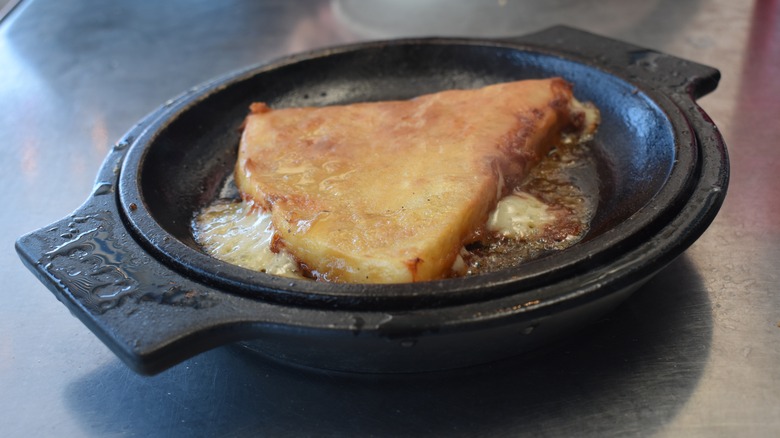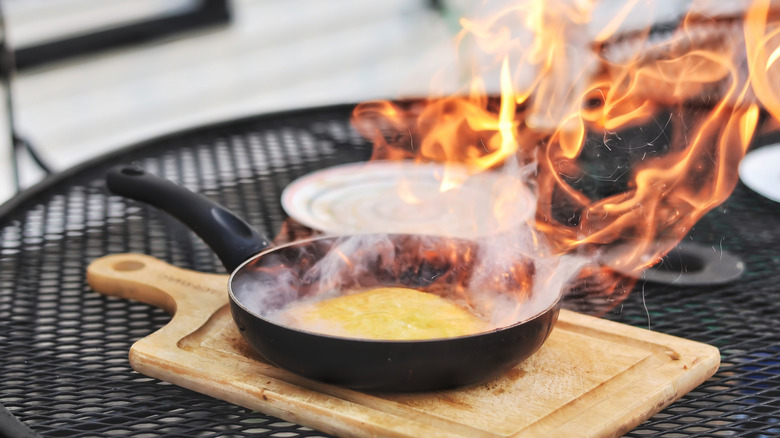Saganaki, The Greek Fried Cheese You Have To Stop Sleeping On
Of all the possible word combinations in the English language, is there any more appealing than "fried cheese"? Sure, frying cheese probably isn't the best idea from a health standpoint, but we literally can't help but love it. Psychology Today suggests that humans are hardwired to crave fatty foods because they are highly calorie-dense, something we needed in our hunter-gatherer days. According to Gizmodo, fat's crispy and creamy textures are inherently pleasing to us, and fat can prolong the release of other flavors in food. Some have even suggested that fat is our sixth taste, alongside sweet, sour, salty, bitter, and umami.
It's no wonder many cultures worldwide enjoy some variety of fried cheese. In the U.S., mozzarella sticks and cheese curds are perennial favorites of the appetizer section, but that's just the tip of the iceberg. Insider takes an international tour of cheese dishes, highlighting Germany's fried camembert, India's paneer, and Cyprus's halloumi, which, though more typically grilled, can also be fried. Even China, which for all its culinary glory is not well-known for dairy products, enjoys a goat's milk cheese called rubing, which can be roasted, steamed, or fried. But if we're talking pure fried cheese deliciousness, it's hard to beat Greece's saganaki.
The name 'saganaki' actually refers to cookware
Strictly speaking, saganaki does not need to include cheese. According to Britannica, saganaki is any dish made in a small, double-handled pan ('sahan' is the Turkish word for a copper dish). Seafood versions incorporating shrimp and mussels are quite popular in their own right, but the best-known version features fried cheese. This type of saganaki starts with a block of flour-coated, pan-fried cheese that forms a crispy brown crust. It's typically served with pita bread, although Food & Wine notes that some Greek restaurants top it with honey and nuts.
Saganaki can be made from many different kinds of cheese, though they tend to be sturdy blocks in the vein of halloumi. Britannica lists kefalotyri, kefalograviera, and kasseri as popular choices. While these cheeses aren't well-known in the U.S., they should be. MasterClass describes kefalotyri as salty and tangy with a short aging period of just a few months. Kefalograviera is usually aged a bit longer and, per Cheese Atlas, has a relatively firm texture. It also has tiny holes — similar to Swiss cheese – throughout. Kasseri is a bit of an outlier because, according to Cheese.com, it has a meltier texture akin to provolone or mozzarella. All three kinds of cheese are made from sheep's milk, sometimes mixed with goat milk.
Saganaki has close ties with Greece ... and Chicago
If you order saganaki at a Greek restaurant in the U.S., it will probably come with a tableside show. Britannica notes that servers often top it with brandy and set it on fire before dousing the flame with lemon juice. Sometimes the brandy is substituted with ouzo, a spirit flavored with fennel or anise. It's Greece's national drink and the only country that produces it (via Discover Greece). Shouts of "opa" often accompany the lighting of saganaki. This iconic Greek phrase doesn't have a strict definition, but ThoughtCo. notes that it is commonly used as an expression of joy or acclaim.
A plate of flaming saganaki is a real showstopper, but it's not authentically Greek. Britannica notes that the practice is a hallmark of Greek restaurants in North America, and it turns out that's precisely where it started. Chicago Magazine reveals that the tradition of flambéing saganaki began at The Parthenon, a restaurant in Chicago's Greektown. Some have criticized the practice as gimmicky, but the majority opinion was one of delight. The Parthenon closed in 2016 after 48 years of business, but its flaming saganaki lives on at countless Greek eateries throughout the United States.


